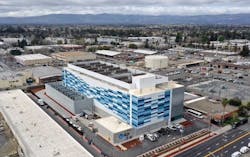NTT Global Data Centers Americas is in building mode in 2021, adding large new data centers in major markets. Today the company opened its new site in Santa Clara, which is NTT’s first presence in the supply-constrained Silicon Valley market.
It’s the third new market this year for NTT Global Data Centers Americas (formerly RagingWire) following the launch of data centers in Suburban Chicago and Hillsboro, Oregon. The company now has six large campuses across the United States, with additional campuses in Northern Virginia, Dallas and Sacramento.
Silicon Valley is the technology capital of America, and one of the country’s largest and most important data center markets. With the COVID-19 pandemic creating demand for more cloud capacity, the Silicon Valley market is positioned for growth, and NTT is one of several providers expanding there.
“We are excited to open this new data center in the highly sought-after Silicon Valley market as it represents the next step in our strategic expansion to all key U.S. markets,” said Doug Adams, the CEO of NTT Global Data Centers Americas. “We’re continuing to put our clients at the center by meeting them where they want to be – in this case in the tech capital of the world – and evaluating options for future expansion.”
Engineered for Earthquake Protection
The NTT Santa Clara SV1 project arrives with a differentiator – the 16-megawatt facility features a base isolation system to provide an extra layer of earthquake protection. The decision is influenced by NTT’s experience in Japan, where base isolation is commonly used in high-rise buildings in urban areas. But it has relevance in the data center cluster in Santa Clara, which lies between the San Andreas and Hayward faults.
“All providers in the Santa Clara region build data centers to withstand earthquakes, but our base isolation design goes a step further,” said Brittany Miller, VP of Construction and Design for NTT Global Data Centers Americas. “Not only does it protect the physical four-story building, but it also protects the mission-critical IT equipment and infrastructure inside the building from strong earthquakes. This system has been proven to work in several data centers in Japan, which is known for having severe earthquakes, and we wanted to add that extra peace of mind for our clients in Silicon Valley.”
Santa Clara has become the region’s primary data center hub, due to its lower cost of electric power. Although land is hard to find in the region, developers have found ways around the challenge. Rather than building on open land in other towns, developers have paid more to acquire properties in Santa Clara with existing buildings that must be torn down and redeveloped.
That was the approach taken by NTT, which bought a 3.3-acre site in Santa Clara last year for its first facility in Silicon Valley, RagingWire/NTT began working with Paradigm Structural Engineers to create a base isolation system for the four-story data center.
A base isolation system for earthquake protection is installed in the early phases of construction at the NTT Global Data Centers Americas SV1 site in Santa Clara, Calif. (Image: NTT)
Isolator systems can be designed to experience movement ranging from two feet to five feet. Designing for additional motion will require larger isolators. RagingWire/NTT is using triple-friction pendulum (TFP) bearings, which will be about 6 feet in diameter. The system will also include viscous dampers, which provide passive energy dissipation by passing a piston through a shaft filled with viscous fluid, similar to shock absorbers. At the Santa Clara building, these dampers will limit the range of motion to 32 inches in either direction.
A similar base isolation system was used by NTT to protect its data centers in Tokyo, Japan from damage during a 9.1-magnitude earthquake and tsunami in 2011.
With SV1, RagingWire is using a data center design optimized for hyperscale cloud companies and large enterprises. The 160,000 square-foot, four-story facility will yield 64,000 square feet of data floor space and 16 megawatts of critical IT power.






